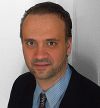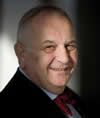 |
Track: Business Architecture
Tuesday, October 19 — 2:00 - 5:30
2:00 - 2:45
Business Architecture: Representation of the Properties of a Structure
Presenter: Harry Hendrickx, CTO, Certified Global EA, HP
In this presentation Harry Hendrickx will share with the audience how he captures the business strategy and vision and translates these into the properties that the working model of an enterprise, wholly or in part, should have to succeed. His approach is practical and he uses a controlled language to recognize and describe the business properties. His approach is critical for successful business IT alignment. He applies the language of marketers, and combines these with the modelling techniques of business consultants and IT architects. Especially the conventions of information architects have been useful to formalize the controlled language. First he will explain the limited list of concepts and meanings that he uses. Then he will have a walkthrough of the steps he takes to get from the entrepeneur’s or CxO vision to the larger question: which information is needed by the business, and how it can or must be exchanged or stored from a business perspective. Finally he will show what the business architecture is from his perspective. The approach will be illustrated with real cases, and he argues that it is not necessary that a company has the strategy documented in detail. Implicit strategies can be captured as well.
Intended audience:
architects with more strategic interest
Key takeaways:
- both implicit and explicit strategies can be captured
- business vision and strategies can be captured in a controlled way
- it is possible to describe the properties of a business and its building blocks
- it is possible to describe the properties of an architecture and the challenges it poses
Presenter: Harry Hendrickx, CTO, Certified Global EA, HP
 Harry Hendrickx is Chief Technology Officer and enterprise architect at HP Enterprise Services, Communications, Entertainment and Media Industry Unit. His major tasks are architecture management and support of large transformation programs. Harry Hendrickx is Chief Technology Officer and enterprise architect at HP Enterprise Services, Communications, Entertainment and Media Industry Unit. His major tasks are architecture management and support of large transformation programs.
Since joining EDS in August 2007, recently integrated with HP, Hendrickx has had several assignments as member of the CTO team in the CME Industry Unit. Last year he won and led an enterprise architecture engagement for a greenfield launch in Asia. He also supported a global 1st tier operator in enhancing her joined integration capability with HP Application Management. Hendrickx is also involved in developing standards in the field of architecture as well as the communications sector. He co-chairs for example the workgroup of TMF and The Open Group that maps and identifies the synergies between the frameworks of these standards organizations.
Besides enterprise architecture governance is one of his specialties. His focus currently is on enhancing the architecture capability in outsourcing relationships as well as within organizational boundaries. Exploiting open standards like TOGAF and TMF is one of his specialties.
Hendrickx has more than 20 years experience in business IT alignment, and has practiced several roles: business consultant, business architect, enterprise architect, and project lead of architecture engagement.
He has also been one of the initiators of the Netherlands Architecture Forum and has been a member in the board from 2002-2007 responsible for establishing and enhancing workgroups in selected areas.
Hendrickx has also earned a PhD at the University of Tilburg based on research in governance in the practice of CIOs. At this university he has also graduated as an economist.
2:45 - 3:30
Business Architecture Domains: A Common Controlled Vocabulary, with Illustrative Case Study
Presenter: Robert Bratulic, Global SME, Telecommunications Business Architecture, IBM
Business architecture domains and concepts are the building blocks of a common controlled vocabulary for business architects. For example, the domains of capability, process, and rule define what a business does and how a business does it. Organization, customer and supplier define who does what inside and outside the enterprise. Intent defines why something is being done or should be done while the things being done include initiatives and projects. Metrics and measures provide a way to assess progress towards goals and to track performance. Products, services and resources define what an enterprise produces, what is delivers to customers, what is received from suppliers and the resources used internally to accomplish certain tasks.
We will walk through a set of over 30 key business architecture domains, and the key concepts they contain. We will look at some of the key standards that map to these domains, including BMM, BPMN, etc, as well as key artifacts that embody the domain concepts like scorecards and RACI diagrams. To make the discussion tangible, we will illustrate the business architecture domains using a case study of a telecommunications service provider building a business architecture. The content is based on work developed by the OMG Business Architecture Special Interest Group – Mapping Project, which is mapping artifacts that relate business architecture concepts, domains and standards, and in effect describing a common controlled vocabulary for business architecture. Also referenced will be key ideas from the OMG white paper entitled “Defining Requirements for a Business Architecture Standard.
Intended audience:
business architects, business analysts
Key takeaways:
- begin to express business architecture using a controlled vocabulary based on a set of business architecture domains and concepts
- understand business architecture domains in terms of a case study, which will bring key concepts to life
- be able to use business architecture domains to test the completeness of one's own business architecture frameworks, tools and techniques
Presenter: Robert Bratulic, Global SME, Telecommunications Business Architecture, IBM
 Robert Bratulic has over 20 years of global telecommunications experience, with a focus on bridging business and IT. He is the Global SME for Telecom Process/Business Architecture in the IBM Global Telecom Center of Excellence. Robert Bratulic has over 20 years of global telecommunications experience, with a focus on bridging business and IT. He is the Global SME for Telecom Process/Business Architecture in the IBM Global Telecom Center of Excellence.
He is an active member of the TMForum, The Open Group Business Architecture Work Group, and the OMG Business Architecture Special Interest Group, where he chairs the Business Architecture Mapping Initiative.
3:30 - 4:00
BREAK
4:00 - 4:45
Architecture: From Inconvenient Truth to Enormous Opportunity
Sjir Nijssen , PNA Group, Netherlands / Serge Valera, Senior Software Engineer, European Space Agency
The workshop is based on the results of a multi organizational working group that has used the real world case of the Nobel Prize to propose repeatability, validation and clarity in architecture land. The workshop will be structured as follows. It starts by handling the questions: What is an architecture? How to make the concept architecture as tangible as a bull or a horse? The speaker will discuss the business value of an architecture and will explain his view on how to derive an architecture. An architecture is an artefact that is the result of a process. At the start of the process a limited set of axioms is taken as true and certain goals are defined, then via logical reasoning the artefact architecure will be derived. In this process the real world example of the Nobel Prize Foundation is used to derive and test the intermediate results of and final artefact of the concept architecture. What follows is an overview and comparison of derived and existing Architectures. The concept of the Architecture Ecosystem will be discussed, highlighting some of the problems, values, and advantages of architecture. This is supported by practical illustrations of architectures and their business value.
Intended audience:
business architects
Key takeaways:
- What is the best starting point or are the starting points?
- How to test an architecture? Where is there evidence that existing architectures have been tested?
- How does business communication and business value relate to architecture?
- Why does architecture matter to the business?
- How to avoid problems of architectures?
- How to maximize advantage of architectural considerations?
Sjir Nijssen , PNA Group, Netherlands
 Dr. Sjir Nijssen is CTO at PNA Group in the Netherlands (www.PNA-Group.nl). Dr. Nijssen started with fact based business modeling in the early seventies. In his function of Head of the Data Base Management Research of Control Data Corporation he and his 20 professionals further developed the fact based methodology and software to support it. It was there where NIAM (Natural language Information Analysis Method), a fact based business practice and notation, was conceived. Since then fact based modelling has been more than his full-time occupation. After holding a position as professor of Computer Science for seven years, he founded the company PNA in 1989, exclusively dedicated to delivering business requirements, consulting and educational services fully based on fact orientation. PNA is since 2009 a member of the European project ONTORULE. PNA is currently developing for ESA advanced software for business modelling. PNA employs 30+ professionals. Dr. Nijssen can be reached directly at sjir.nijssen@pna-group.nl Dr. Sjir Nijssen is CTO at PNA Group in the Netherlands (www.PNA-Group.nl). Dr. Nijssen started with fact based business modeling in the early seventies. In his function of Head of the Data Base Management Research of Control Data Corporation he and his 20 professionals further developed the fact based methodology and software to support it. It was there where NIAM (Natural language Information Analysis Method), a fact based business practice and notation, was conceived. Since then fact based modelling has been more than his full-time occupation. After holding a position as professor of Computer Science for seven years, he founded the company PNA in 1989, exclusively dedicated to delivering business requirements, consulting and educational services fully based on fact orientation. PNA is since 2009 a member of the European project ONTORULE. PNA is currently developing for ESA advanced software for business modelling. PNA employs 30+ professionals. Dr. Nijssen can be reached directly at sjir.nijssen@pna-group.nl
Serge Valera, Senior Software Engineer, European Space Agency
 Serge Valera is a senior software engineer of the European Space Agency (www.esa.int). As member of the ESTEC Software Systems division, his main role consists in managing the development of EGSE (Electrical Ground Support Equipments) systems (including databases), used to monitor and control satellites (or part of them) during their assembly, integration and testing. In the context of databases, he is focusing on the subject of sharing knowledge between all partners involved in the development and operations of space systems and has participated in the production of an European standard (ECSS-E-TM-10-23A, www.ecss.nl) on integrated architecture for solving the knowledge interoperability challenge. He has been using formal methods (based on fact based modelling) for more than 15 years. Serge is currently involved in the development of a new generation of fact based modelling tool for use in the European Space business, contract given to PNA Group. He is also convenor of a working group of experts in the generic domain of fact based modelling, working group whose purpose is to standardize means of exchanging conceptual data models between data modelling notations and tools. Serge Valera is a senior software engineer of the European Space Agency (www.esa.int). As member of the ESTEC Software Systems division, his main role consists in managing the development of EGSE (Electrical Ground Support Equipments) systems (including databases), used to monitor and control satellites (or part of them) during their assembly, integration and testing. In the context of databases, he is focusing on the subject of sharing knowledge between all partners involved in the development and operations of space systems and has participated in the production of an European standard (ECSS-E-TM-10-23A, www.ecss.nl) on integrated architecture for solving the knowledge interoperability challenge. He has been using formal methods (based on fact based modelling) for more than 15 years. Serge is currently involved in the development of a new generation of fact based modelling tool for use in the European Space business, contract given to PNA Group. He is also convenor of a working group of experts in the generic domain of fact based modelling, working group whose purpose is to standardize means of exchanging conceptual data models between data modelling notations and tools.
4:45 - 5:30
Panel Discussion
Moderator: Dave van Gelder, Global Architect, Capgemini, Netherlands

 Return to previous page Return to previous page
|
|
|